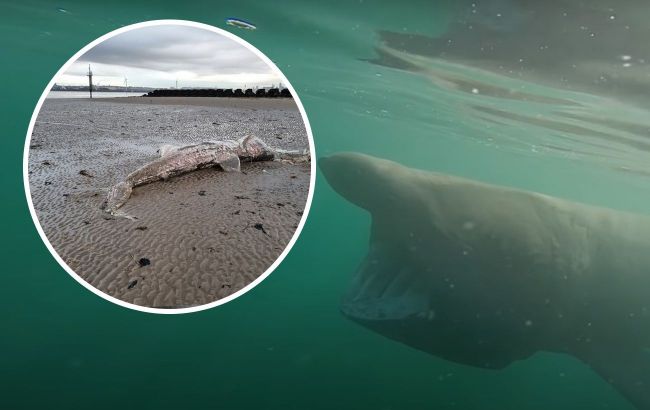Mysterious 6-meter sea monster washes ashore in Britain, Photo
 In the UK, remains of a sea monster found on the shore (Collage by RBC-Ukraine)
In the UK, remains of a sea monster found on the shore (Collage by RBC-Ukraine)
New Brighton resident Stephen Davies discovered the remains of a massive sea creature during his morning jog near the River Mersey at the mouth of Liverpool Bay in the UK. The water had carried the remains onto a sandy spit, reports Science alert.
Local residents quickly dubbed the remains of the sea creature a "giant alien" or "New Brighton Nessie." Not surprisingly, the body of the massive fish measured about 6 meters in length.
However, it turned out to be the body of a giant shark that is not native to these waters. Most likely, it was washed ashore by the current due to recent strong storms.
"I was running on the beach and thought 'what's that?' because it looked quite big. I was talking to a fisherman who said it was a basking shark, which I don't think is fairly common around here, but it could have been washed in by the tide. I have never come across anything like it before," said Stephen Davies.
The giant shark is the second-largest fish inhabiting the seas around the UK. They move slowly, collecting tiny zooplankton in their powerful mouths, which can be up to a meter wide. According to the Wildlife Trust, this species is most commonly encountered in the summer months and is known to frequent the coasts of southwest England, Wales, the Isle of Man, and western Scotland.
Despite its size, the deceased shark found in New Brighton was likely a juvenile, as adult giant sharks can reach up to 40 feet (12 meters) in length and weigh up to six tons.
The Wildlife Trust stated, "Satellite tracking has revealed migration over long distances in winter, with some appearing off the Azores volcanic islands and Newfoundland. Some fishermen report still seeing them in the UK during midwinter, and occasionally they wash up dead after winter storms."
The carcass was removed from the beach using a forklift.

Photo: Remains of a giant shark
In terms of size, the giant shark is second only to the whale shark and is one of the largest fish on Earth. The name of its genus comes from the Greek term meaning "sea monster." These sharks prefer warmer waters and often surface with their mouths wide open.
Throughout history, giant sharks have been associated with terrifying creatures due to their large size and unique feeding habits. Ancient sailors feared that these colossal sea monsters were exactly that; their enormous size alone was enough to fuel speculation about horrifying creatures hiding beneath the waves. Tales of sea serpents arose from observations of filter-feeding sharks swimming on the water's surface.
However, these gentle giants are not dangerous predators. They typically move slowly, capturing tiny zooplankton with their massive mouths, which can reach up to a meter in width.
Despite their slow pace, a 2018 study showed that compared to great white sharks, these giant fish can leap completely out of the water at a stunning speed of about 5 meters per second.
Their distinctive features are arranged in a way that further distorts their appearance, contributing to misconceptions and mystery. Decomposition usually begins with the lower part of the head, dorsal, and tail fins, creating a resemblance to a plesiosaur.
Giant sharks are listed on the IUCN Red List as vulnerable due to the threat of overfishing and accidental entanglement in fishing gear.
Earlier, we wrote about whether sea serpents should be feared.

